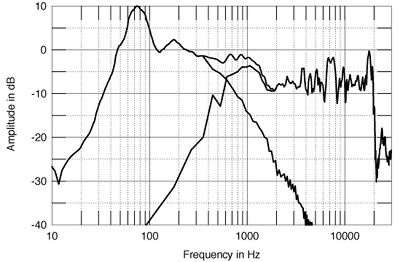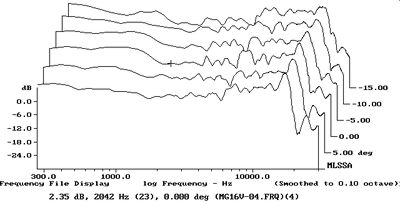| Columns Retired Columns & Blogs |
Magnepan Magneplanar MG1.6/QR loudspeaker Measurements
Sidebar 3: Measurements
The MG1.6/QR plays significantly quieter than the Thiel CS2.3 for the same voltage input. I estimated its B-weighted sensitivity at a low 83.7dB(B)/2.83V/m, though this will be moderated somewhat by its line-source behavior in-room. Its impedance (fig.1) is basically that of a 4.5 ohm resistor, modified by the crossover, which results in the peak at 600Hz. Any good 4-ohm-rated amplifier should be able to drive the Maggie without difficulty. There are no cabinet resonances—the MG1.6/QR doesn't have a cabinet.

Fig.1 Magnepan MG1.6/QR, electrical impedance (solid) and phase (dashed) (2 ohms/vertical div.).
The somewhat complicated graph in fig.2 shows the Magnepan's response on the ribbon axis halfway along its length, averaged across a 30 degrees horizontal window and overlaid by the individual outputs of the Magneplanar woofer and the quasi-ribbon tweeter. The acoustic crossover point appears to be 600Hz, as specified. Though there are many small peaks and dips, the balance through the treble is flat, but the tweeter level appears shelved-down compared with that of the woofer. Though this will be partly due to proximity effect at the close microphone distance employed (see my "Measuring Loudspeakers" article elsewhere in this issue), it is also characteristic of the speaker. The apparent rise in the lower midrange is partly real and partly due to proximity effect, though the trend is smooth.

Fig.2 Magnepan MG1.6/QR, acoustic crossover and anechoic response on central tweeter axis at 50" (the latter averaged across 30 degrees horizontal window), corrected for microphone response, with the nearfield woofer response plotted below 300Hz.
The large peak in the octave between 50Hz and 100Hz is a function of the woofer diaphragm's tuning. This will be ameliorated somewhat by the dipole cancellation referred to by BD in his report. However, in-room measurements I took of the MG1.6/QR did reveal an energy excess in this same region; I'm not surprised that BD found the speaker to sound "a bit boosted in the upper bass."
Fig.3 shows the '1.6's actual responses taken over a wide, +15, -10 degrees vertical window. The line-source behavior renders the speaker very forgiving with respect to listener ear height. Laterally, things are more complicated. What would otherwise be straightforward dipole behavior is overlaid by the lobing that you would normally find in the vertical plane with a two-way speaker with the tweeter mounted above the woofer. The off-axis differences in response are shown in fig.4, with those on the woofer side of the panel at the back of the graph. The dipole behavior is significant below 2kHz or so. Above that region, there are some frequencies where the dispersion is much wider than at others—it is possible that these, together with the peakiness noted in the on-axis response, contribute to BD's finding the speaker to be balanced somewhat forward in the low treble.

Fig.3 Magnepan MG1.6/QR, vertical response family at 50", from back to front: responses 15 degrees-5 degrees above central HF axis; reference response; responses 5 degrees-10 degrees below central HF axis.

Fig.4 Magnepan MG1.6/QR, lateral response family at 50", normalized to response on tweeter axis, from back to front: differences in response 90 degrees-5 degrees off-axis on woofer side of panel; reference response; differences in response 5 degrees-90 degrees off-axis on tweeter side of panel.
Despite its flatness, the MG1.6 is not a time-coherent design, at least not on its tweeter axis. The step response on this axis (fig.5) reveals the tweeter to be connected in inverted acoustic polarity, and its output leads that of the woofer by a small fraction of a millisecond. Finally, the Maggie's cumulative spectral-decay plot (fig.6) is relatively clean in the low treble, though there are hints of some low-frequency energy storage. The mid- and high-treble regions, however, appear to have some delayed energy problems. I am never sure with large-diaphragm speakers if this behavior represents resonances or the presence of multiple reflections. But again, it might correlate with BD's finding the treble to be balanced a little forward.—John Atkinson

Fig.5 Magnepan MG1.6/QR, step response on tweeter axis at 50" (5ms time window, 30kHz bandwidth).

Fig.6 Magnepan MG1.6/QR, cumulative spectral-decay plot at 50" (0.15ms risetime).
- Log in or register to post comments




































